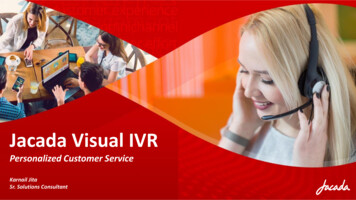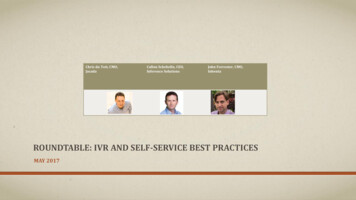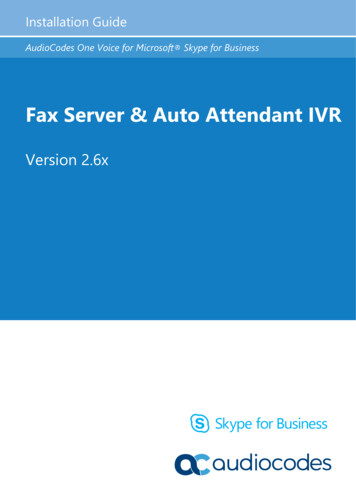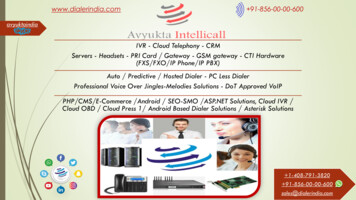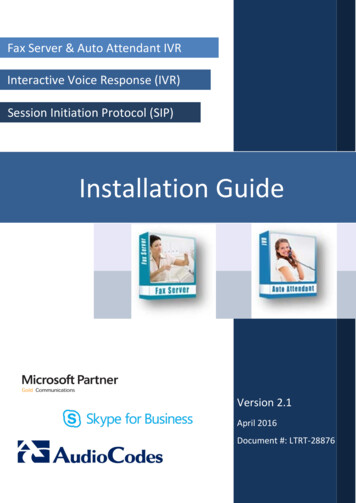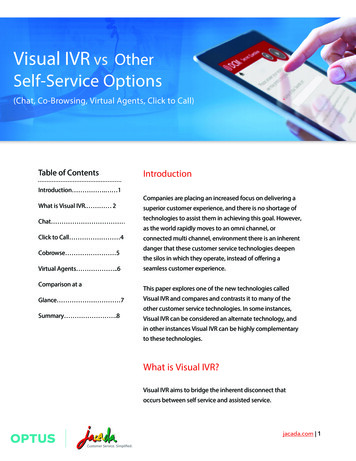
Transcription
Visual IVR vs OtherSelf-Service Options(Chat, Co-Browsing, Virtual Agents, Click to Call)Table of ContentsIntroductionIntroduction . 1What is Visual IVR. 2Chat 2Click to Call 4Cobrowse 5Virtual Agents .6Comparison at aGlance 7Summary .8Companies are placing an increased focus on delivering asuperior customer experience, and there is no shortage oftechnologies to assist them in achieving this goal. However,as the world rapidly moves to an omni channel, orconnected multi channel, environment there is an inherentdanger that these customer service technologies deepenthe silos in which they operate, instead of offering aseamless customer experience.This paper explores one of the new technologies calledVisual IVR and compares and contrasts it to many of theother customer service technologies. In some instances,Visual IVR can be considered an alternate technology, andin other instances Visual IVR can be highly complementaryto these technologies.What is Visual IVR?Visual IVR aims to bridge the inherent disconnect thatoccurs between self service and assisted service.jacada.com 1
“Over 44% ofcustomers surveyedindicated that havingquestions answered bya live person whiledoing online shoppingis one of the mostimportant features of awebsite”ForresterConsumers feel this pain every day, navigating a traditionalvoice IVR tree, only to be asked for the same informationwhen connected to an agent. This disconnect occurs onalmost all platforms - for example, engaging in an onlinechat session operates in a silo - when a customer is forcedto abandon the chat session and call the company, there isno continuity of that interaction and the customer starts atthe beginning.Visual IVR provides a visual interface to assist the customer,either on their mobile phone or directly on your website.This visual interface can replace your existing cumbersomeVoice IVR prompts, or can offer even more sophisticatedself service options to further reduce your inbound calls.And for those calls that still need to be made, Visual IVRconnects that self service session with the agent, ensuringthe call starts warm with no repeating of information.This paper reviews the pros and cons of the variouscustomer service technologies, compares and contraststhem to Visual IVR and explores how they can be deployedtogether to mutually benefit the company and thecustomer.ChatChat is ubiquitous in the web landscape today - thanks tofar lower price points (free at the low-end), there is rarely acustomer facing website that doesn’t have chat. Moresophisticated Chat offerings can run into hundreds ofdollars per month per agent. There can be little doubt thatChat is successful as a customer service technology. Over44% of customers surveyed indicated that having questionsanswered by a live person while doing online shopping isone of the most important features of a website, and injacada.com 2
“Companies have seena 30-50% improvementin shopping cartabandonment afterimplementing chat”particular, companies have seen a 30-50% improvement inshopping cart abandonment after implementing chat1.The cost with Chat is not related purely to the technology,but rather with the cost of staffing a sufficient number oftrained chat agents. Chat is rarely, if ever, a self servicevehicle and is only an alternate conduit to speaking with anagent. These agents need to be specially trained inmanaging chat (typing skills, managing multiple sessionsand more) and proper routing mechanisms must be inplace, all increasing the total cost of ownership of a chatsolution.Chat offers nocontinuity to a voicesession when the needarises to call theorganization causingsignificant customerfrustration when thecustomer effectivelystarts the voice callfrom the beginningagain.Where chat starts to fail is when the issue cannot beresolved within the chat session. Chat offers no continuityto a voice session when the need arises to call theorganization causing significant customer frustration whenthe customer effectively starts the voice call from thebeginning again.Visual IVR and Chat are highly complementary. A commonstrategy employed is to offer customers a “help” button onyour website - neither a chat button nor a phone numberjust a single entry point to obtaining service. Once pressed,a Visual IVR session is invoked that will understand thecustomers call intent, attempt to resolve the inquiry wherepossible, and if necessary, offer a chat session or a voicecall, with full continuity during the handoff.Visual IVR also lowers cost by reducing inbound chatvolume on the front end of the customer interaction byoffering self service options, or by bridging the disconnectbetween the chat session and a voice call on the back endof the interaction.1Forrester, Making Proactive Chat Work, June 4, 2010jacada.com 3
Click to call“69% of customers areexpecting to hopacross channelsseamlessly”ForresterClick to call, also known as callback, offers customers theoption to receive a call from the company under theauspices of reducing waiting times for the customer. Whilethis is partially true, it is often used to balance staffing ofagents and call the customer back at a time that’sconvenient for the company, not necessarily for thecustomer. And today’s ‘real time on demand’ customerexpects to interact with your company at the moment theydecide to, not later at some undetermined time.While these solutions have tremendous ROI for thecompany2, they do little to significantly improve thecustomer experience. There is no self service component tothis technology, and worse, there is no continuity of the self"Visual IVR solutionservices the customerat that moment thecustomer reaches outfor assistance andattempts to first resolvethe customer inquiryinstead of blindlyscheduling a call back.”service session to the call back. At best, the calling agentmay have your account number or call reason, but has noinsight into the prior web self service session. And it’s notjust the disconnected experience that hurts the customerexperience, it’s forcing the customer through a singlechannel journey. In fact, shoppers are six times more likelyto call your 1-800 number than to request a callback3,indicating the importance of offering your customerschoice. According to Forrester, 69% of customers areexpecting to hop across channels seamlessly4.Contrast this to a Visual IVR solution that services thecustomer at that moment the customer reaches out forassistance, not 20 minutes or five hours later, and attemptsto first resolve the customer inquiry instead of blindlyscheduling a call 304.pdf3North American Technographics Customer Experience, Marketing And Consumer Technology Online Survey, Q3 20074Forrester Research, December 2014 Global eBusiness and Channel Strategy Professional Online Surveyjacada.com 4
For organizations that have an existing callback solution,Visual IVR can easily front this solution by first offering selfCustomers today wanta choice of channels –Visual IVR extends yourcallback solution toprovide them thischoice.service options in the hope of reducing the need for a call,and then schedule a callback with the customer ifnecessary. This ensures that customers can interact in themanner preferred by them, whether that’s filling out a formto receive a callback, dialing immediately, engaging in achat or starting a self service session. Put simply, customerstoday want a choice of channels – Visual IVR extends yourcallback solution to provide them this choice.CobrowseCobrowse solutions allow an agent to view the customersweb browser or desktop, and to even take control to guidethe customer or complete the transaction. Originally thesesolutions found great success in desktop support – showinga customer how to install software or troubleshoot anoperating system issue.However, cobrowse is less successful in a pure customerservice environment, for a number of reasons.“If you need Cobrowseto assist a customer tocomplete a form,perhaps you shouldredesign the form”ForresterFirst is that self service web sites have grown more andmore sophisticated, with state of the art User Interfacesand improving technology reducing the need for agentassistance. As Forrester put it, if you need Cobrowse toassist a customer to complete a form, perhaps you shouldredesign the form!5Second, customers often perceive sharing their desktop orbrowser as an intrusion into their sphere of privacy, and5Forrester, http://blogs.forrester.com/diane clarkson/11-03-03-co browsing a technology worth consideringjacada.com 5
third, if you need an agent to assist you in a cobrowsesituation, you may as well abandon the self service natureof the transaction and go to full assisted service instead.Visual IVR alleviates these concerns by putting thecustomer in control of their self service session, ensuringthat less agent assisted sessions are needed. Moreover,Visual IVR has a far greater ‘reach’ than cobrowse, allowingcustomers to resolve their inquiry via the traditional voicechannel as well as the web or mobile channel.Virtual Agents“Virtual Agents often donot understand thecontext of the question,are poorly configured,and end up beingnothing more than ahyped up knowledgebase search”Virtual Agents (a “chat bot’) are growing in popularity – afterall, it sounds appealing from an investment perspective –you offer your customers chat without needing to staff chatagents. Unfortunately this view is not a customer centricview, and ultimately increases customer frustration.Much like the earlier Voice IVR’s that struggled withaccurate voice recognition, Virtual Agents often do notunderstand the context of the question, are poorlyconfigured, and end up being nothing more than a hypedup knowledge base search (putting lipstick on theproverbial pig, if you will!).Implementation costs of Virtual Agents are higher than theyfirst appear. Deep knowledge base integration is needed inorder to have an even moderately effective virtual agent.Even more complex are multi-step interactions where thecontext needs to be carried over from one question to thenext. Instead, the best use case for Virtual Agents seem tobe collecting some information at the start of an interactionand transitioning to a live agent, either based on customerfrustration (listening for words of frustration) or as ajacada.com 6
standard practice.Virtual Agents are forcing customers through a singlejourney which often ends in frustration. In contrast, VisualIVR is about offering a choice to your customers. Moreimportantly, unlike Virtual Agents, the design principle ofVisual IVR recognizes that you cannot force self service on acustomer, and you need to offer a seamless bridge toassisted service for those times that self service fails.Comparison at aGlancejacada.com 7
SummaryVisual IVR is the next generation of customer servicetechnology, being the first solution to seamlessly blend selfservice with assisted service across multiple channels,o ering a personalized and connected experience to yourcustomers. Visual IVR delivers a superior customerexperience, reduces inbound call volume and does so witha tremendous return on investment.The ability for a customer to jump in and out of self servicesessions and agent assisted sessions with full continuity asthey complete their journey is an industry first and ischanging the customer experience landscape. No othertechnology puts so much focus on reducing the customere ort, driving loyalty and increasing the top line.Interestingly, Visual IVR can actually complement yourexisting self service technology such as Chat or Click-To-Call,allowing you to achieve a greater ROI on those investments,and improve the customer experience they deliver.Because Visual IVR can be implemented in days or weeksand has a demonstrable ROI of 3-6 months, organizationsshould take a serious look at implementing this technologyor risk losing out to competitors.Optus Business partners with Jacada to deliverVisual IVR solutions as your single point ofcontact for solution and service. For moreinformation and specialist assistance contactyour Optus account manager or call the OptusBusiness Hotline on 1800 555 937optus.com.au/businessjacada.com 8
Visual IVR and compares and contrasts it to many of the other customer service technologies. In some instances, Visual IVR can be considered an alternate technology, and . jacada.com 2 “Over 44% of customers

